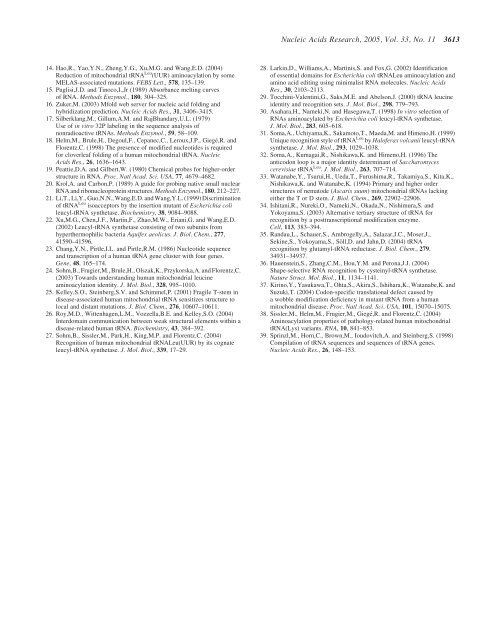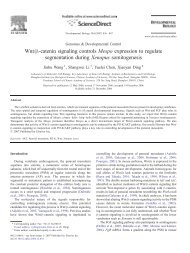Screen PDF - Nucleic Acids Research
Screen PDF - Nucleic Acids Research
Screen PDF - Nucleic Acids Research
Create successful ePaper yourself
Turn your PDF publications into a flip-book with our unique Google optimized e-Paper software.
<strong>Nucleic</strong> <strong>Acids</strong> <strong>Research</strong>, 2005, Vol. 33, No. 11 361314. Hao,R., Yao,Y.N., Zheng,Y.G., Xu,M.G. and Wang,E.D. (2004)Reduction of mitochondrial tRNA Leu (UUR) aminoacylation by someMELAS-associated mutations. FEBS Lett., 578, 135–139.15. Puglisi,J.D. and Tinoco,I.,Jr (1989) Absorbance melting curvesof RNA. Methods Enzymol., 180, 304–325.16. Zuker,M. (2003) Mfold web server for nucleic acid folding andhybridization prediction. <strong>Nucleic</strong> <strong>Acids</strong> Res., 31, 3406–3415.17. Silberklang,M., Gillum,A.M. and RajBhandary,U.L. (1979)Use of in vitro 32P labeling in the sequence analysis ofnonradioactive tRNAs. Methods Enzymol., 59, 58–109.18. Helm,M., Brule,H., Degoul,F., Cepanec,C., Leroux,J.P., Giegé,R. andFlorentz,C. (1998) The presence of modified nucleotides is requiredfor cloverleaf folding of a human mitochondrial tRNA. <strong>Nucleic</strong><strong>Acids</strong> Res., 26, 1636–1643.19. Peattie,D.A. and Gilbert,W. (1980) Chemical probes for higher-orderstructure in RNA. Proc. Natl Acad. Sci. USA, 77, 4679–4682.20. Krol,A. and Carbon,P. (1989) A guide for probing native small nuclearRNA and ribonucleoprotein structures. Methods Enzymol., 180, 212–227.21. Li,T., Li,Y., Guo,N.N., Wang,E.D. and Wang,Y.L. (1999) Discriminationof tRNA Leu isoacceptors by the insertion mutant of Escherichia colileucyl-tRNA synthetase. Biochemistry, 38, 9084–9088.22. Xu,M.G., Chen,J.F., Martin,F., Zhao,M.W., Eriani,G. and Wang,E.D.(2002) Leucyl-tRNA synthetase consisting of two subunits fromhyperthermophilic bacteria Aquifex aeolicus. J. Biol. Chem., 277,41590–41596.23. Chang,Y.N., Pirtle,I.L. and Pirtle,R.M. (1986) Nucleotide sequenceand transcription of a human tRNA gene cluster with four genes.Gene, 48, 165–174.24. Sohm,B., Frugier,M., Brule,H., Olszak,K., Przykorska,A. and Florentz,C.(2003) Towards understanding human mitochondrial leucineaminoacylation identity. J. Mol. Biol., 328, 995–1010.25. Kelley,S.O., Steinberg,S.V. and Schimmel,P. (2001) Fragile T-stem indisease-associated human mitochondrial tRNA sensitizes structure tolocal and distant mutations. J. Biol. Chem., 276, 10607–10611.26. Roy,M.D., Wittenhagen,L.M., Vozzella,B.E. and Kelley,S.O. (2004)Interdomain communication between weak structural elements within adisease-related human tRNA. Biochemistry, 43, 384–392.27. Sohm,B., Sissler,M., Park,H., King,M.P. and Florentz,C. (2004)Recognition of human mitochondrial tRNALeu(UUR) by its cognateleucyl-tRNA synthetase. J. Mol. Biol., 339, 17–29.28. Larkin,D., Williams,A., Martinis,S. and Fox,G. (2002) Identificationof essential domains for Escherichia coli tRNALeu aminoacylation andamino acid editing using minimalist RNA molecules. <strong>Nucleic</strong> <strong>Acids</strong>Res., 30, 2103–2113.29. Tocchini-Valentini,G., Saks,M.E. and Abelson,J. (2000) tRNA leucineidentity and recognition sets. J. Mol. Biol., 298, 779–793.30. Asahara,H., Nameki,N. and Hasegawa,T. (1998) In vitro selection ofRNAs aminoacylated by Escherichia coli leucyl-tRNA synthetase.J. Mol. Biol., 283, 605–618.31. Soma,A., Uchiyama,K., Sakamoto,T., Maeda,M. and Himeno,H. (1999)Unique recognition style of tRNA Leu by Haloferax volcanii leucyl-tRNAsynthetase. J. Mol. Biol., 293, 1029–1038.32. Soma,A., Kumagai,R., Nishikawa,K. and Himeno,H. (1996) Theanticodon loop is a major identity determinant of Saccharomycescerevisiae tRNA Leu . J. Mol. Biol., 263, 707–714.33. Watanabe,Y., Tsurui,H., Ueda,T., Furushima,R., Takamiya,S., Kita,K.,Nishikawa,K. and Watanabe,K. (1994) Primary and higher orderstructures of nematode (Ascaris suum) mitochondrial tRNAs lackingeither the T or D stem. J. Biol. Chem., 269, 22902–22906.34. Ishitani,R., Nureki,O., Nameki,N., Okada,N., Nishimura,S. andYokoyama,S. (2003) Alternative tertiary structure of tRNA forrecognition by a posttranscriptional modification enzyme.Cell, 113, 383–394.35. Randau,L., Schauer,S., Ambrogelly,A., Salazar,J.C., Moser,J.,Sekine,S., Yokoyama,S., Söll,D. and Jahn,D. (2004) tRNArecognition by glutamyl-tRNA reductase. J. Biol. Chem., 279,34931–34937.36. Hauenstein,S., Zhang,C.M., Hou,Y.M. and Perona,J.J. (2004)Shape-selective RNA recognition by cysteinyl-tRNA synthetase.Nature Struct. Mol. Biol., 11, 1134–1141.37. Kirino,Y., Yasukawa,T., Ohta,S., Akira,S., Ishihara,K., Watanabe,K. andSuzuki,T. (2004) Codon-specific translational defect caused bya wobble modification deficiency in mutant tRNA from a humanmitochondrial disease. Proc. Natl Acad. Sci. USA, 101, 15070–15075.38. Sissler,M., Helm,M., Frugier,M., Giegé,R. and Florentz,C. (2004)Aminoacylation properties of pathology-related human mitochondrialtRNA(Lys) variants. RNA, 10, 841–853.39. Sprinzl,M., Horn,C., Brown,M., Ioudovitch,A. and Steinberg,S. (1998)Compilation of tRNA sequences and sequences of tRNA genes.<strong>Nucleic</strong> <strong>Acids</strong> Res., 26, 148–153.







